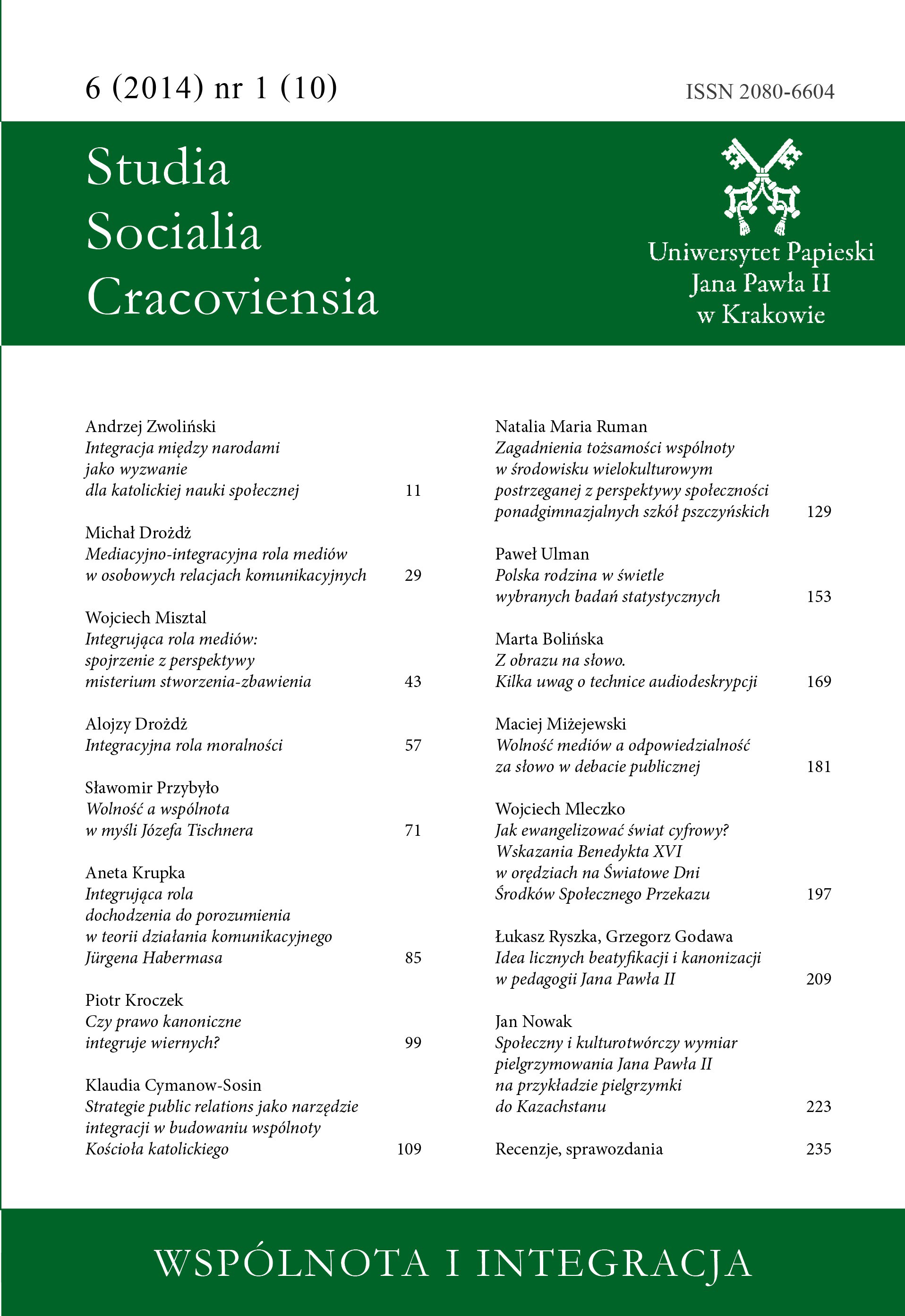From picture to word. A few remarks on the technique of audio description
DOI:
https://doi.org/10.15633/ssc.763Keywords:
audio description, description technique, intersemiotic translation, the visually impaired, cultureAbstract
Audio description involves recounting (without interpretation and commentary) what is happening, for example, in a film or a theater play, in dialogues between charac-ters, but it also attempts to describe the space, e.g.: monuments or works of art. Translation of visual content into words, or otherwise, verbal description of visible layers of plays, audiovisual productions, art and entertainment events makes them available to the blind and visually impaired as well as to those with poor eyesight.
Audio description has been cultivated in Europe since the 1980s. Since 2006, it has been popularized in Poland too. In the sketch, we refer to the essence of audio description providing an overview of the history and discussing the basic workshop rules as well as its role culture promotion.
References
Bardijewska S., O znakach radiowych, [w:] Z zagadnień semiotyki sztuk masowych, pod red. A. Helman i in., Wrocław 1977, s. 119–137.
Bardijewska S., Z problemów radiowej adaptacji prozy, „Pamiętnik Teatralny” 1977, z. 3–4, s. 540–549.
Fiołek-Lubczyńska B., Film, telewizja i komputery w edukacji humanistycznej: o audiowizualnych tekstach kultury, Kraków 2004.
Fras J., Dziennikarski warsztat językowy, Wrocław 1999.
Hendrykowski M., Język ruchomych obrazów, Poznań 1999.
Hendrykowski M., Słowo w filmie: historia, teoria, interpretacja, Warszawa 1982.
Hopfinger M., Adaptacje utworów literackich w polskim filmie okresu powojennego, [w:] Problemy socjologii literatury, pod red. J. Sławińskiego, Wrocław 1971, s. 467–490.
Kaziów M., O dziele radiowym. Z zagadnień estetyki oryginalnego słuchowiska, 1973.
Maas V. F., Uczenie się przez zmysły. Wprowadzenie do teorii integracji sensorycznej, tłum. E. Grzybowska, Z. Przyrowski, M. Ślifirska, Warszawa 1998.
Mayen J., Radio a literatura, Warszawa 1965.
Mikuta J., Kultura żywego słowa, Częstochowa 2001.
Osuchowska B., Poradnik autora, tłumacza i redaktora, Warszawa 2005.
Smyk-Batorska A., Magia żywego słowa, Kielce 2008.
Stasiński P., Dramaturgia radiowa, [w:] Słownik literatury polskiej XX wieku, pod red. A. Brodzkiej i in., Wrocław 1992, s. 217–222.
Stasiński P., Dramaturgia telewizyjna, w: Słownik literatury polskiej XX wieku, pod red. A. Brodzkiej i in., Wrocław 1992, s. 222–227.
Sujak E., ABC psychologii komunikacji, Warszawa 2006.
Tomaszkiewicz M., Techniki tłumaczenia audiowizualnego, Warszawa 2004.
Wert P., Podstawy typologii widowiska telewizyjnego, [w:] Styl i kompozycja. Konferencje teoretycznoliterackie w Toruniu i Ustroniu, pod red. J. Trzynadlowskiego, Wrocław 1965, s. 310–319.
Wert P., Widowisko telewizyjne jako forma podawcza epiki literackiej, [w:] Styl i kompozycja. Konferencje teoretycznoliterackie w Toruniu i Ustroniu, pod red. J. Trzynadlowskiego, Wrocław 1965, s. 320–330.
Żuchowska W., Szansa w metodzie, „Nowa Polszczyzna” 2 (1998) 7, s. 3–5.
Źródła internetowe:
www.bip.mkidn.gov.pl/media/docs/20100714_rtv-rada_minsistrow.pdf/ (10.07.2012). www.tyfloswiat.pl/FAD_ustawa_medialna (02.01.2014).
www.nina.gov.pl/docs/default-document-library/Wprowadzenie%20do%20audiodeskrypcji.pdf?sfvrsn=1 (02.01.2014).
www.audiodeskrypcja.org.pl/index.php/standardy-tworzenia-audiodeskrypcji/do-produkcji-audiowizualnych (02.03.2014).
www.audiodeskrypcja.org/news.php?readmore=72 (03.01.2014).
www.acb.org/adp/docs/ADP Standards.doc (06.01.2014).
www.jostrans.org/issue07/art orero wharton.pdf (06.01.2014).
www.pl.wikipedia.org/wiki/Audiodeskrypcja (06.01.2014).
Downloads
Published
Issue
Section
License
Copyright (c) 2015 Marta Bolińska

This work is licensed under a Creative Commons Attribution-NonCommercial-NoDerivatives 3.0 Unported License.
Authors who publish with this journal agree to the following terms:
- Authors retain the copyright and full publishing rights without restrictions, and grant the journal right of first publication with the work simultaneously licensed under a Creative Commons Attribution 4.0 International License that allows others to share the work with an acknowledgement of the work's authorship and initial publication in this journal.
- Authors are able to enter into separate, additional contractual arrangements for the non-exclusive distribution of the journal's published version of the work (e.g., post it to an institutional repository or publish it in a book), with an acknowledgement of its initial publication in this journal.
- Authors are permitted and encouraged to post their work online (e.g., in institutional repositories or on their website) prior to and during the submission process, as it can lead to productive exchanges, as well as earlier and greater citation of published work (See The Effect of Open Access).

